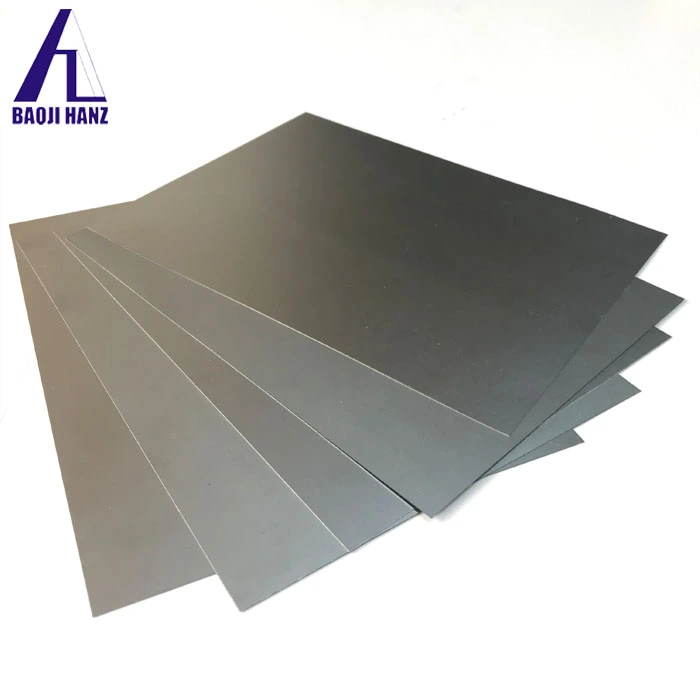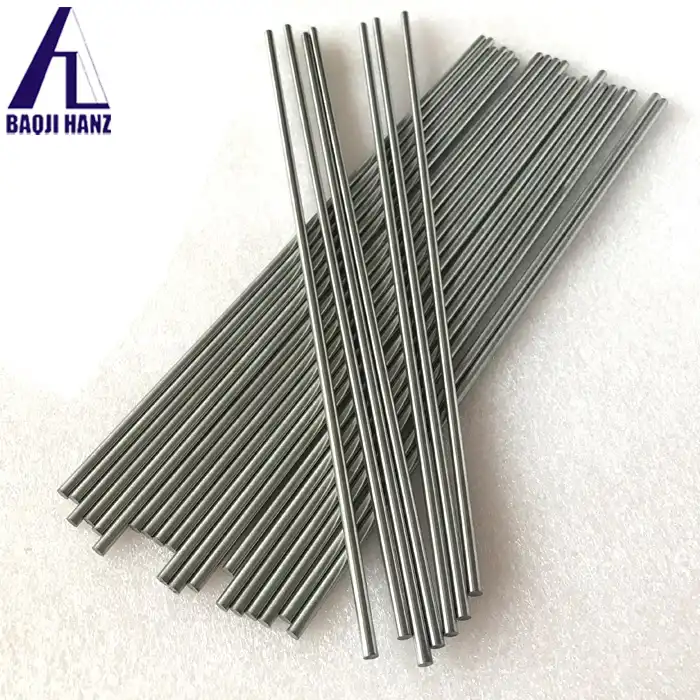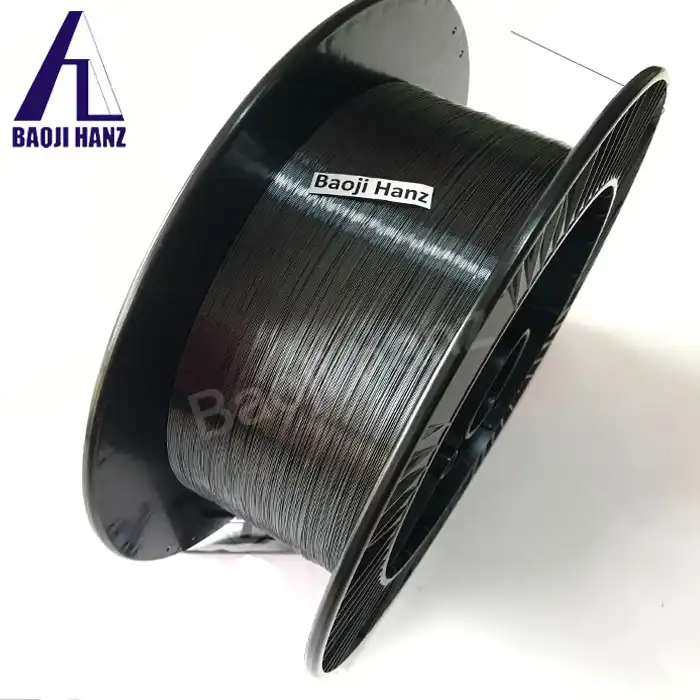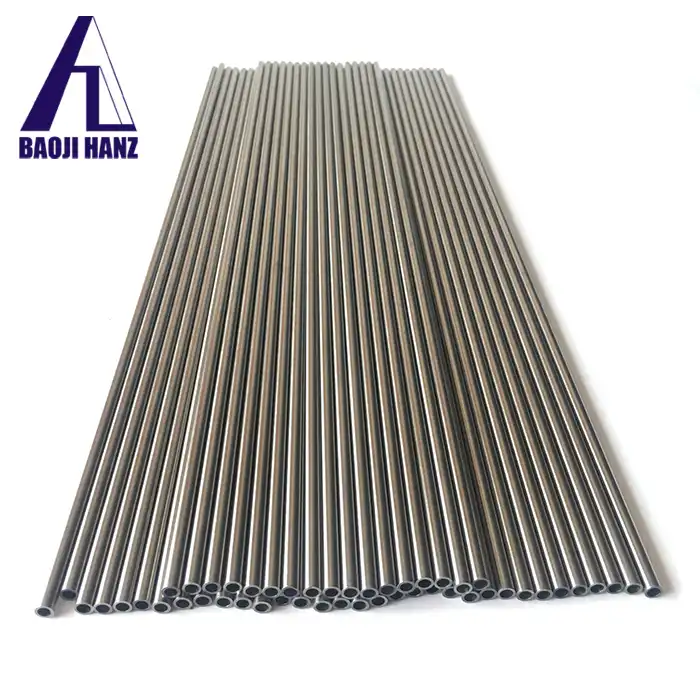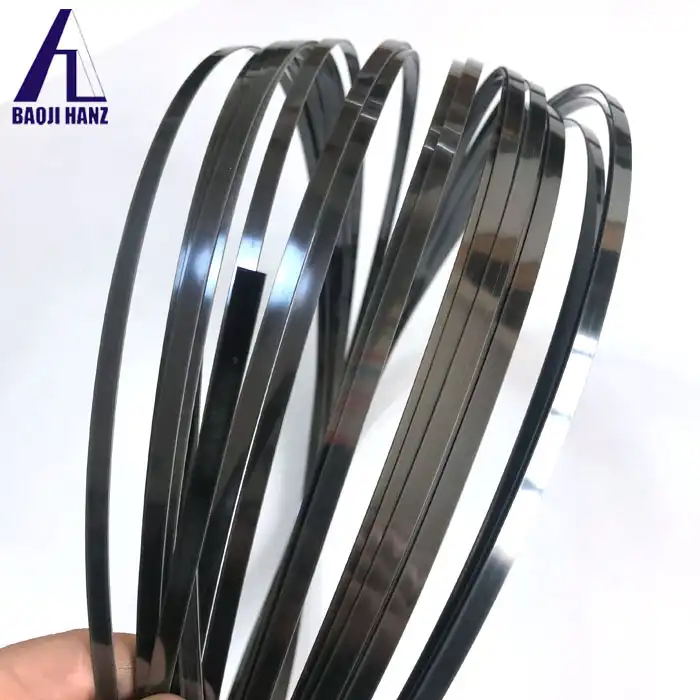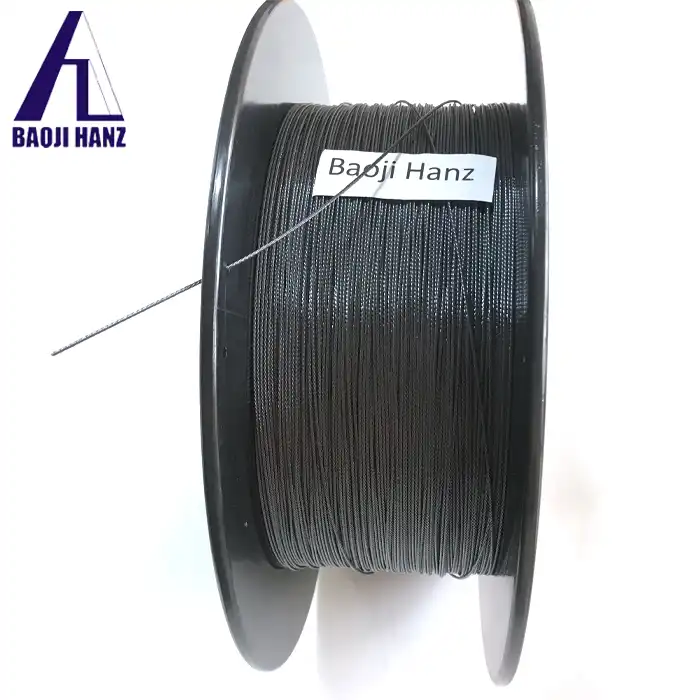What are the advantages of using a nitinol guide wire in medical procedures?
2025-01-23 20:59:15
Nitinol guide wires have revolutionized medical procedures, offering unparalleled benefits in minimally invasive surgeries and interventional treatments. These super elastic nitinol guide wires possess unique properties that make them ideal for navigating complex anatomical structures with precision and safety. In this comprehensive exploration, we'll delve into the numerous advantages of using nitinol guide wires in medical procedures, examining their superior flexibility, shape memory capabilities, and biocompatibility. By understanding these benefits, healthcare professionals can make informed decisions about incorporating nitinol guide wires into their practices, ultimately improving patient outcomes and procedural efficiency.
The Unique Properties of Nitinol Guide Wires
Super Elasticity: A Game-Changer in Medical Procedures
The super elasticity of super elastic nitinol guide wires is a remarkable characteristic that sets them apart from traditional materials. This property allows the wire to undergo significant deformation without permanent damage, enabling it to navigate tortuous blood vessels and complex anatomical structures with ease. The ability to bend and flex without kinking or breaking is crucial in delicate procedures where precision and control are paramount. Moreover, the super elastic nature of nitinol guide wires contributes to their exceptional kink resistance. This means that even when subjected to sharp bends or twists, the wire maintains its structural integrity and performance. As a result, medical professionals can manipulate the guide wire with confidence, knowing that it will maintain its shape and function throughout the procedure. The super elasticity of nitinol also translates to improved patient comfort. The wire's ability to conform to the natural curves of the body's vessels and cavities reduces the risk of trauma to surrounding tissues. This gentle interaction with delicate structures minimizes patient discomfort and lowers the likelihood of complications during and after the procedure.
Shape Memory: Adapting to Anatomical Challenges
One of the most fascinating properties of it is their shape memory capability. This unique characteristic allows the wire to "remember" a predetermined shape and return to it when exposed to specific temperatures or stresses. In medical procedures, this property can be leveraged to create guide wires that adapt to the patient's anatomy in real-time. The shape memory effect enables nitinol guide wires to navigate complex vascular structures with unprecedented ease. For instance, a wire can be designed to form a specific curve or bend when it reaches body temperature, allowing it to naturally conform to the shape of a blood vessel or organ. This adaptive behavior significantly enhances the wire's ability to access hard-to-reach areas, making it invaluable in procedures such as angioplasty or neurovascular interventions. Furthermore, the shape memory property of nitinol guide wires contributes to their excellent pushability and trackability. These wires can be straightened for insertion and then recover their pre-set shape once in place, providing optimal support and guidance for subsequent devices or instruments. This characteristic not only improves the efficiency of procedures but also reduces the risk of vessel perforation or tissue damage.
Biocompatibility: Ensuring Patient Safety
The biocompatibility of super elastic nitinol guide wires is a crucial factor in their widespread adoption in medical procedures. Nitinol, an alloy of nickel and titanium, demonstrates excellent compatibility with human tissues, making it an ideal material for use in the body. This biocompatibility translates to a reduced risk of adverse reactions and improved patient outcomes. One of the key aspects of nitinol's biocompatibility is its corrosion resistance. When exposed to bodily fluids, nitinol forms a stable oxide layer on its surface, which acts as a protective barrier against further corrosion. This resistance to degradation ensures that the guide wire maintains its structural integrity and performance throughout the procedure, minimizing the risk of material breakdown and potential complications. Additionally, the hypoallergenic nature of nitinol makes it suitable for use in patients with metal sensitivities. While nickel allergies are relatively common, the unique composition and surface properties of nitinol significantly reduce the likelihood of allergic reactions. This makes nitinol guide wires a safe choice for a wide range of patients, including those with known metal sensitivities.
Enhancing Procedural Outcomes with Nitinol Guide Wires
Improved Navigation in Complex Anatomies
The exceptional flexibility and shape memory properties of nitinol guide wires significantly enhance navigation in complex anatomical structures. In procedures involving tortuous blood vessels or intricate organ systems, these wires can be manipulated with precision, allowing medical professionals to access hard-to-reach areas with greater ease and control. The ability of nitinol guide wires to maintain their shape and resist kinking is particularly valuable when navigating through narrow or winding passages. This characteristic reduces the need for multiple wire exchanges during a procedure, saving time and minimizing the risk of complications associated with repeated insertions and withdrawals. Moreover, the super elastic nature of nitinol guide wires allows for smoother advancement through calcified or stenotic lesions. The wire's ability to flex and adapt to these challenging anatomical features enables medical professionals to overcome obstacles that might otherwise impede the progress of conventional guide wires.
Increased Procedural Efficiency and Success Rates
The use of nitinol guide wires can significantly improve procedural efficiency and success rates across a wide range of medical interventions. The wire's unique properties contribute to shorter procedure times, reduced radiation exposure for both patients and medical staff, and improved overall outcomes. The exceptional trackability of nitinol guide wires allows for smoother and more precise delivery of subsequent devices, such as catheters or stents. This can lead to more accurate placement of therapeutic devices and a reduction in the number of attempts required to achieve optimal positioning. As a result, procedures become more streamlined, potentially reducing patient discomfort and the risk of complications. Furthermore, the durability and resilience of nitinol guide wires contribute to their longevity during complex procedures. This reduces the need for wire replacements, which can be time-consuming and potentially disruptive to the flow of the intervention. The ability to rely on a single wire throughout a procedure can lead to more consistent and predictable outcomes.
Enhanced Patient Safety and Comfort
Patient safety and comfort are paramount in any medical procedure, and nitinol guide wires offer several advantages in this regard. The super elastic properties of these wires allow for gentler navigation through blood vessels and other anatomical structures, reducing the risk of vessel trauma or perforation. The kink resistance of nitinol guide wires also contributes to patient safety by minimizing the risk of wire fracture or separation during a procedure. This reduces the potential for complications such as embolism or the need for additional interventions to retrieve broken wire fragments. Moreover, the biocompatibility of nitinol ensures minimal tissue reaction and reduces the risk of inflammation or allergic responses. This is particularly important in procedures where the guide wire may be in contact with tissues for extended periods, such as in certain neurovascular or cardiac interventions.
Applications and Future Developments of Nitinol Guide Wires
Diverse Medical Applications
The versatility of super elastic nitinol guide wires has led to their adoption across a wide range of medical specialties and procedures. In cardiology, these wires are instrumental in coronary angioplasty and stent placement, where their ability to navigate complex vascular structures is invaluable. The super elastic properties of nitinol guide wires allow cardiologists to access and treat even the most challenging coronary lesions with greater precision and safety. In the field of neurovascular interventions, nitinol guide wires play a crucial role in procedures such as embolization of cerebral aneurysms and treatment of arteriovenous malformations. The wire's flexibility and shape memory capabilities enable neurointerventionalists to navigate the delicate and tortuous blood vessels of the brain with unprecedented control and safety. Urology is another specialty that has benefited significantly from the use of nitinol guide wires. In procedures such as ureteroscopy and percutaneous nephrolithotomy, these wires facilitate access to the urinary tract and kidney stones, allowing for more efficient and less traumatic interventions. The kink resistance and shape memory of nitinol guide wires are particularly advantageous in navigating the complex anatomy of the urinary system.
Ongoing Research and Innovation
The field of nitinol guide wire technology is continuously evolving, with ongoing research aimed at further enhancing their performance and expanding their applications. One area of focus is the development of surface modifications to improve the wire's lubricity and reduce friction during insertion and manipulation. These advancements could lead to even smoother navigation and reduced risk of vessel trauma. Another promising avenue of research involves the integration of nitinol guide wires with advanced imaging technologies. By incorporating radiopaque markers or developing nitinol alloys with enhanced visibility under fluoroscopy, researchers aim to improve the wire's visibility during procedures. This could lead to more precise navigation and reduced reliance on contrast agents, potentially improving patient safety and reducing procedural complexity. Researchers are also exploring the potential of combining nitinol with other materials to create composite guide wires with tailored properties. For example, incorporating carbon nanotubes or other nanomaterials into nitinol could enhance its strength and flexibility while maintaining its biocompatibility. These hybrid materials could open up new possibilities for even more challenging medical procedures and interventions.
Expanding Horizons in Minimally Invasive Procedures
As minimally invasive techniques continue to advance, nitinol guide wires are poised to play an increasingly important role in pushing the boundaries of what is possible in medical interventions. The ongoing miniaturization of medical devices and instruments relies heavily on the unique properties of materials like nitinol to maintain functionality at smaller scales. In the emerging field of robotic-assisted surgery, nitinol guide wires are being explored as a means to enhance the precision and dexterity of robotic instruments. The wire's super elasticity and shape memory capabilities could enable the development of more advanced and flexible robotic tools, capable of navigating complex anatomical structures with unprecedented accuracy. Furthermore, the potential applications of nitinol guide wires extend beyond traditional medical procedures. Researchers are investigating their use in targeted drug delivery systems, where the wire's shape memory properties could be leveraged to create deployable drug-eluting structures. This could revolutionize the treatment of localized conditions, allowing for more precise and controlled delivery of therapeutic agents.
Conclusion
The advantages of using super elastic nitinol guide wires in medical procedures are numerous and significant. Their unique properties of super elasticity, shape memory, and biocompatibility have revolutionized minimally invasive interventions across various medical specialties. As research and innovation continue, the potential for nitinol guide wires to further enhance patient care and expand the frontiers of medical science remains immense. If you want to get more information about this product, you can contact us at: baojihanz-niti@hanztech.cn.
h2>Properties and Characteristics of Shape Memory Nitinol Foil Superelasticity and Shape Memory Effect
Shape memory nitinol foil exhibits two extraordinary properties that set it apart from conventional materials: superelasticity and the shape memory effect. Superelasticity allows the foil to undergo substantial deformation without permanent damage, returning to its original shape upon unloading. This property is particularly useful in applications requiring flexibility and resilience. The shape memory effect enables the foil to "remember" and return to a predetermined shape when heated above its transformation temperature. This unique characteristic opens up a world of possibilities for creating smart, responsive structures and devices.
Temperature-Dependent Behavior
The behavior of theShape memory nitinol foil is intricately linked to temperature. At lower temperatures, the material exists in a martensite phase, which is easily deformable. As the temperature increases, it transitions to the austenite phase, triggering the shape memory effect. This temperature-dependent behavior allows for precise control over the material's properties, making it ideal for applications in thermal management and temperature-sensitive devices. The ability to fine-tune the transformation temperature through composition adjustments further enhances the versatility of the product.
Mechanical and Physical Properties
Shape memory nitinol foil boasts an impressive array of mechanical and physical properties. Its high strength-to-weight ratio makes it an excellent choice for lightweight yet durable components. The material's corrosion resistance surpasses that of many conventional alloys, ensuring longevity in harsh environments. Additionally, the ptoduct exhibits good biocompatibility, making it suitable for medical implants and devices. Its electrical and thermal conductivity properties also contribute to its utility in various applications, from sensors to actuators.
Manufacturing Processes of Shape Memory Nitinol Foil
Alloy Composition and Melting
The production of shape memory nitinol foil begins with careful control of the alloy composition. Precise amounts of nickel and titanium are combined to achieve the desired properties. The melting process typically involves vacuum induction melting or vacuum arc remelting to ensure high purity and homogeneity of the alloy. These advanced melting techniques are crucial for maintaining the consistency and quality of the final product, as even small variations in composition can significantly affect the foil's performance.
Casting and Hot Working
After melting, the nitinol alloy is cast into ingots or billets. These are then subjected to hot working processes such as forging or hot rolling to break down the as-cast structure and improve the material's properties. Hot working helps to refine the grain structure and enhance the mechanical properties of the alloy. The temperature and deformation parameters during this stage are carefully controlled to ensure optimal performance of the product.
Cold Rolling and Heat Treatment
The hot-worked material undergoes cold rolling to achieve the desired foil thickness. This process involves multiple passes through precision rollers, gradually reducing the thickness while increasing the length. Cold rolling also introduces work hardening, which affects the material's properties. Subsequent heat treatment is crucial to impart the shape memory and superelastic properties to the foil. This heat treatment, often referred to as "shape setting," involves heating the foil to a specific temperature and holding it in the desired shape before cooling. The precise temperature and duration of this process are tailored to achieve the optimal shape memory behavior for the intended application.
Applications of Shape Memory Nitinol Foil
Medical Devices and Implants
Shape memory nitinol foil has found extensive use in the medical field, revolutionizing the design of minimally invasive devices and implants. In cardiovascular applications, nitinol foil is used to create self-expanding stents that can be compressed for insertion and then expand to their predetermined shape once in place. This property allows for less invasive procedures and reduced trauma to patients. Orthodontic archwires made from nitinol foil provide constant, gentle force for tooth alignment, improving comfort and reducing treatment time. In neurosurgery, shape memory nitinol foil is utilized in aneurysm clips and guidewires, offering enhanced maneuverability and precision during delicate procedures.
Aerospace and Automotive Industries
The unique properties of the Shape memory nitinol foilmake it an invaluable material in aerospace and automotive applications. In aircraft, nitinol foil is used in variable geometry chevrons for jet engines, which can adapt their shape to optimize performance and reduce noise during different flight phases. The automotive industry employs nitinol foil in actuators for climate control systems and in adaptive damping systems for improved ride comfort. The material's high fatigue resistance and ability to withstand extreme temperatures make it ideal for these demanding applications. Additionally, shape memory nitinol foil is explored for use in morphing aircraft structures and self-healing automotive components, pushing the boundaries of what's possible in vehicle design and performance.
Consumer Electronics and Robotics
Shape memory nitinol foil has made significant inroads into consumer electronics and robotics, enabling the creation of more compact and responsive devices. In smartphones and tablets, nitinol foil is used in haptic feedback mechanisms, providing tactile sensations that enhance user experience. The material's superelasticity is exploited in flexible antennas and connectors, allowing for more durable and bendable electronic devices. In robotics, shape memory nitinol foil actuators offer a lightweight alternative to traditional motors, enabling the development of more agile and energy-efficient robots. Soft robotics, in particular, benefits from the material's ability to change shape in response to electrical stimuli, opening up new possibilities for adaptive and biomimetic designs.
Conclusion
Shape memory nitinol foil has emerged as a versatile and innovative material with a wide range of applications across various industries. Its unique properties of shape memory and superelasticity have enabled the development of groundbreaking technologies in medicine, aerospace, automotive, and consumer electronics. As research continues to uncover new possibilities for this remarkable material, we can expect to see even more exciting applications in the future, pushing the boundaries of what's possible in engineering and design. If you want to get more information about this product, you can contact us at: baojihanz-niti@hanztech.cn.
Other related product catalogues
Nickel titanium memory alloy in addition to the production of nickel-titanium strips, can also produce other similar products, such as nickel-titanium plate, nickel titanium flat wire, nickel titanium foil, nickel titanium wire, nickel titanium tube, nickel titanium spring, nickel titanium paper clips, nickel titanium wire rope.
|
|
|
|
|
|
|
|
References
1.Duerig, T., Pelton, A., & Stöckel, D. (1999). An overview of nitinol medical applications. Materials Science and Engineering: A, 273, 149-160.
2.Pelton, A. R., Schroeder, V., Mitchell, M. R., Gong, X. Y., Barney, M., & Robertson, S. W. (2008). Fatigue and durability of Nitinol stents. Journal of the Mechanical Behavior of Biomedical Materials, 1(2), 153-164.
3.Morgan, N. B. (2004). Medical shape memory alloy applications—the market and its products. Materials Science and Engineering: A, 378(1-2), 16-23.
4.Petrini, L., & Migliavacca, F. (2011). Biomedical applications of shape memory alloys. Journal of Metallurgy, 2011.
5.Yoneyama, T., & Miyazaki, S. (Eds.). (2008). Shape memory alloys for biomedical applications. Elsevier.
6.Stoeckel, D., Pelton, A., & Duerig, T. (2004). Self-expanding nitinol stents: material and design considerations. European Radiology, 14(2), 292-301.

